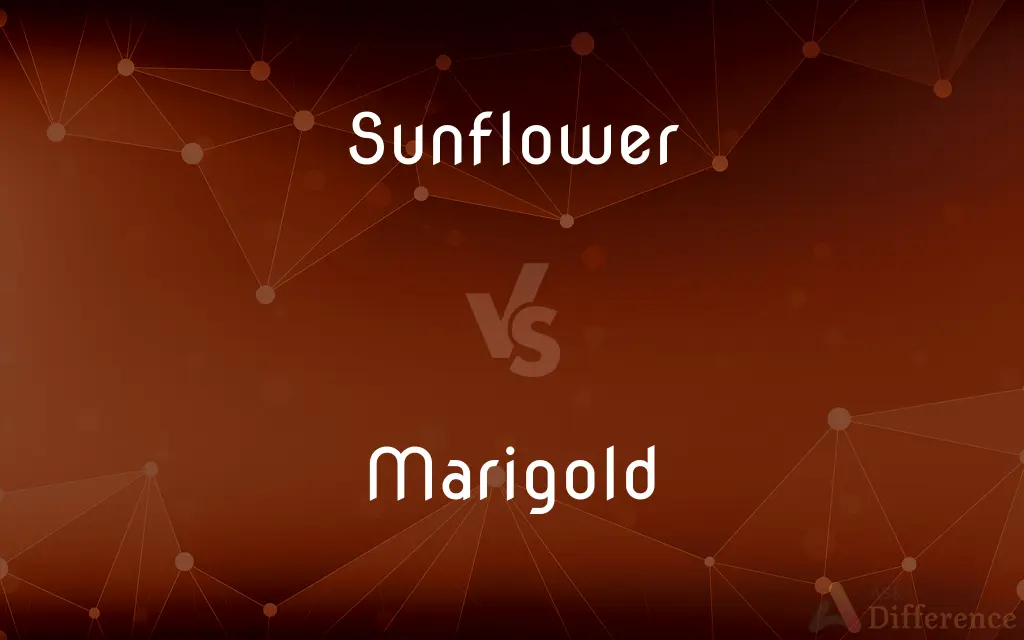Sunflower vs. Marigold — What's the Difference?
By Tayyaba Rehman & Maham Liaqat — Updated on April 22, 2024
Sunflowers are tall plants known for their large, yellow heads and edible seeds, while marigolds are shorter, with vibrant orange or yellow flowers used decoratively and in gardening for pest control.

Difference Between Sunflower and Marigold
Table of Contents
ADVERTISEMENT
Key Differences
Sunflowers, reaching heights of several feet, are characterized by their large, distinctive yellow blooms that follow the sun. Whereas marigolds are generally more compact and feature dense, brightly colored flowers ranging from deep orange to yellow.
Sunflowers are primarily grown for their seeds, which are harvested for food and oil, a significant agricultural crop. On the other hand, marigolds are prized in gardening not only for their aesthetic appeal but also for their ability to deter garden pests naturally.
Sunflowers symbolize positivity and strength, often associated with the sun due to their appearance and movement towards light. Conversely, marigolds are often linked with celebration and remembrance in cultural festivals and are used in religious ceremonies.
Sunflowers require full sun and well-drained soil, thriving in gardens and farms, while marigolds are more versatile, growing well in varied soil types and conditions, including containers. Sunflowers have a rough, hairy stem and large leaves, distinguishing them from marigolds, which have a finer, sometimes fragrant foliage.
Comparison Chart
Height
Tall, several feet high.
Shorter, generally under 3 feet.
ADVERTISEMENT
Flower Appearance
Large, yellow heads with visible seed centers.
Small, dense, orange or yellow flowers.
Uses
Agricultural (seeds for oil and food).
Gardening (decorative, pest control).
Symbolism
Positivity, strength.
Celebration, remembrance.
Soil Requirements
Requires well-drained soil, full sun.
Tolerant of various soils, versatile.
Compare with Definitions
Sunflower
A large plant known for its tall stalks and big, yellow flowers.
Sunflowers towering over the garden fence are a beautiful sight in the summer.
Marigold
Used in gardens for its pest-repellent properties.
He planted marigolds around his vegetable garden to naturally repel insects.
Sunflower
Cultivated for its edible seeds and oil.
The sunflower seeds were harvested for making oil.
Marigold
Often features finely divided, aromatic leaves.
The fragrance of marigold leaves filled the air when brushed against.
Sunflower
Known to turn its head towards the sun.
The field of sunflowers turned towards the sun throughout the day.
Marigold
A small, bushy plant with bright orange or yellow flowers.
Marigolds lined the walkway, adding vibrant color to the landscape.
Sunflower
Symbolizes warmth and positivity.
She wore a sunflower pin to symbolize her optimistic outlook.
Marigold
Associated with cultural and religious ceremonies.
Marigolds are a staple in the floral decorations for the Day of the Dead.
Sunflower
Features a rough, hairy stem.
The sunflower’s stem was too rough to hold without gloves.
Marigold
Grows well in various soil types, including poor soils.
Marigolds thrive even in the nutrient-poor sections of the garden.
Sunflower
Any of several plants of the genus Helianthus of the composite family, especially H. annuus, having tall coarse stems and large, yellow-rayed flower heads that produce edible seeds rich in oil.
Marigold
Any of various North and South American plants of the genus Tagetes of the composite family, widely cultivated for their showy yellow or orange flowers.
Sunflower
A brilliant yellow to strong or vivid orange yellow.
Marigold
Any of several plants having similar flowers, such as calendula or marsh marigold.
Sunflower
Any plant of the genus Helianthus, so called probably from the form and color of its floral head, having the form of a large disk surrounded by yellow ray flowers.
Marigold
Any of the Old World plants, of the genus Calendula, with orange, yellow or reddish flowers.
Sunflower
The commonly cultivated species, Helianthus annuus, a native of America.
Marigold
Any of the New World plants, of the genus Tagetes, with orange, yellow or reddish flowers.
Sunflower
A bright yellow, like that of the flower petals.
Marigold
A million pounds sterling.
Sunflower
Any flat, radially symmetric organic compound such as coronene
Marigold
Rubber glove for cleaning
Sunflower
(pathology) worm-star
Marigold
Having the color of marigolds, a bright yellowish-orange hue.
Sunflower
Any plant of the genus Helianthus; - so called probably from the form and color of its flower, which is large disk with yellow rays. The commonly cultivated sunflower is Helianthus annuus, a native of America.
Marigold
A name for several plants with golden yellow blossoms, especially the Calendula officinalis (see Calendula), and the cultivated species of Tagetes.
Sunflower
Any plant of the genus Helianthus having large flower heads with dark disk florets and showy yellow rays
Marigold
Any of various tropical American plants of the genus Tagetes widely cultivated for their showy yellow or orange flowers
Common Curiosities
Do marigolds require a lot of water?
Marigolds require moderate watering, preferring well-drained soil and becoming drought-tolerant once established.
Are marigolds perennial or annual plants?
Marigolds are generally annuals, meaning they complete their life cycle in one year, though some varieties can be perennials in warmer climates.
What climates are best for growing sunflowers?
Sunflowers thrive in warm climates with full sunlight, ideally in temperate regions.
How often do sunflowers bloom?
Sunflowers typically bloom once per season, from mid-summer to early fall.
Can marigolds help improve soil health?
Yes, marigolds can help suppress nematodes and improve soil health through their root exudates that have bioactive properties.
How quickly do sunflowers reach maturity?
Sunflowers typically reach maturity and bloom within 80 to 120 days, depending on the variety and growing conditions.
What is the significance of sunflowers in art and culture?
Sunflowers are iconic in art and culture, notably in Vincent van Gogh's famous paintings, symbolizing happiness and vitality.
What types of wildlife are attracted to sunflowers?
Sunflowers attract bees, birds (especially finches), and butterflies, which are drawn to their seeds and nectar.
Are marigolds effective in repelling all garden pests?
Marigolds are especially effective against certain nematodes and can deter some insects, but they are not a panacea for all pests.
What part of the sunflower is used for oil production?
The seeds of the sunflower are pressed to extract oil, which is used in cooking and in various industrial applications.
What are the different uses of marigolds in cultural contexts?
Marigolds are used in many cultural contexts, including as offerings in religious ceremonies, decorations in festivals like Dia de los Muertos, and in wedding décor in South Asian cultures.
How do sunflowers help in soil remediation?
Sunflowers can be used in phytoremediation to extract toxic elements like lead, arsenic, and uranium from contaminated soils.
How tall can the largest varieties of sunflowers grow?
The tallest varieties of sunflowers can grow up to 12 feet or more under optimal conditions.
How do marigolds contribute to pest control in organic farming?
In organic farming, marigolds are planted as companion plants to deter pests naturally, reducing the need for chemical pesticides.
Can marigolds be used for medicinal purposes?
Yes, marigolds (particularly Calendula officinalis) are used in traditional medicine for their anti-inflammatory and healing properties.
Share Your Discovery

Previous Comparison
Purse vs. Clutch
Next Comparison
Irani vs. IranianAuthor Spotlight
Written by
Tayyaba RehmanTayyaba Rehman is a distinguished writer, currently serving as a primary contributor to askdifference.com. As a researcher in semantics and etymology, Tayyaba's passion for the complexity of languages and their distinctions has found a perfect home on the platform. Tayyaba delves into the intricacies of language, distinguishing between commonly confused words and phrases, thereby providing clarity for readers worldwide.
Co-written by
Maham Liaqat















































